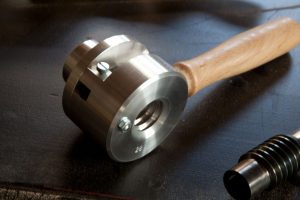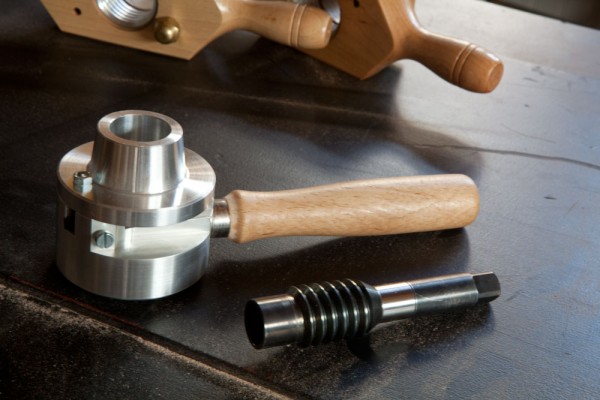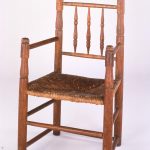We may receive a commission when you use our affiliate links. However, this does not impact our recommendations.
Whenever I write about threadboxes, my personal blog gets swamped with spam from the Pacific Rim. So batten down the firewalls, mateys.
I started writing about the Moxon double-screw vise in 2010 (original post here) and have made many of them using a threadbox and tap that you can buy from many reputable woodworking stores.
My first threadbox worked fine until it needed sharpening. The blade was so brittle that it snapped while I gently stoned it. Since then, I have bought at least five other threadboxes from the same Chinese manufacturer and they all have been hopeless for one reason or another.
The worst problem: the pitch of the threadbox and tap didn’t match. So there was no way the tool would work. And so I beg you not to buy these until the manufacturer improves the product.
Beall Tool Co. makes a nice router-powered version, but not everyone has a router. I’ve been using it when I teach classes where we build a double-screw vise. But I have long wished for a more portable solution. I’ve tried to hunt up some vintage threadboxes, but the ones I have found have been dogmeat.
 So I finally bit the bullet and bought a German one from Dieter-Schmid Fine Tools. Jennie Alexander, author of “Make a Chair from a Tree,” showed me hers recently, which was old enough to be stamped that it was made in “West Germany.” Alexander had only good things to say about the threader, its cutter and the results.
So I finally bit the bullet and bought a German one from Dieter-Schmid Fine Tools. Jennie Alexander, author of “Make a Chair from a Tree,” showed me hers recently, which was old enough to be stamped that it was made in “West Germany.” Alexander had only good things to say about the threader, its cutter and the results.
Her only piece of advice on the tool was to keep it lubricated with tallow.
My 26mm threader showed up last week and I have been eager to try it out. But first I need to turn down some spindles and start them soaking in linseed oil for a couple of days.
While I have high hopes, I wouldn’t run off and buy one of these German ones. If you are OK with metal screws, there are lots of less-expensive ways to make a double-screw vise, including buying Acme-thread rod or even the Benchcrafted hardware.
I want to be able to make hundreds of these vises with students, so for me this tool could be a good value.
— Christopher Schwarz
Obsessed by workholding? Me, too. You might like “The Workbench Design Book” and “Workbenches: From Design & Theory to Construction & Use.” Both are available at ShopWoodworking.com.
Here are some supplies and tools we find essential in our everyday work around the shop. We may receive a commission from sales referred by our links; however, we have carefully selected these products for their usefulness and quality.











Hi Chris,
Perhaps you have provided this information elsewhere, but I would be curious to hear about your experiences with the thread box now that you have had some time to evaluate the product and its value. Thanks.
Steve
I too have the Chinese versions, and got them to work. The tap works ok, the thread box wasn’t cutting a deep enough thread to match the nut though. I first honed the cutter, that improved the cut, but not the issue. I tried advancing the cutter, nope. I studied farther, and finally got out my micrometer, and started running the numbers. The cutter needed to move about .030” (about 1/64″) deeper, so I shaved that much off the V side of the mortice, including having to cut the same amount of the aluminum thread of the thread box, and jammed a piece of shim stock on the top side of the cutter. The aluminum cut fine with my mortice chisel, it’s soft. I wouldn’t use a nice paring chisel for this though. This made the thread depth deeper, and the thread box works fine now. So study the thread box some before you fling it across the shop in a fit of anger.
I just don’t have the kind of money to buy wood working tools. So, I make 90/95% of my tools. The screw box project by Roy Underhill is the patterns that I am using and thus far it looks quite promising. When I am done with that I am moving on to making draw knives. Sometimes I feel like more of a blacksmith than a wood worker. But I love every minute of it!
Jennie Alexander here:
As you say the German Threader is nifty.
Soaking the wood in Linseed Oil is messy, sticky, stinky and unneceassary. Tallow on the stock is all you need. Tallow will sit in a closed container at room temperature for over 30 years. Simple and inexpensive to make. I have made hundreds of screws over the years. I send them to Peter Follansbee who endorses them also.
Footnote: I like Moxon’s term double bench screw. Better than sliced bread,
Jennie
Those are pricey, (but probably worth it if you plan on using them a lot, as Chris certainly is.) One thing to note with Dieter-Schmid Fine Tools is that the initial prices listed on their website include VAT; orders shipped outside the EU don’t include this charge, but you don’t see the non-VAT price until you’ve added the item to your cart. The non-VAT price is 19% less on tools.
Why do you soak the spindles in linseed oil before tapping? The set is expensive, but they look like the classic uber-engineered tooling the Deutschland is known for.
I paid less than that for my first car…and second car!
I have a couple of the cheap-o tap and dies, but haven’t used them much. I’ve found that the dowel for the screw needs to be exactly the right diameter, because if it’s too small it won’t thread properly, and the nut won’t go on. And yes, the cutters are also junk.
My biggest problem is that the threads aren’t coarse enough. Threads on old bench screws, wooden clamps, and finger bolts on planes, marking gauges, etc. are all more coarse, and I sure wish I could make my own threads the same.
If any fine American tool makers like Lie-Nielsen or the like are reading this, it would be great if you’d make tap and die sets to make threads that closely match old wooden threads, and in the same sizes too, from 3/8″ or so to 2-1/2″. Even better, if they resembled traditional tap and dies, I’d probably buy the first one off the line!
Chris,
The 1″ set from W.G…….is it truly inch, or metric equivalent? WHat is the thread pitch, appears to be 6\8 TPI?
I have used 1″ saenc metal cutting tap and die for wood but would prefer coarser pitch.
Chris, I too, have one of the asian made thread boxes, and experienced the same problems you described – I managed to make one ‘pretty good’ set of threads with it, and then the cutter disintegrated. I was given a new cutter free from the folks i bought it from (told them about your article, they read it) and have tried to harden and temper it – just haven’t used it yet – will report back. I’m also trying to make my own cutter for the thing out of 01. Will report back on that, too. Wish I could afford one of those German made ones. Let us know how it works out, will you?
I’ve had better luck than I expected sawing up Bessey CM30 C-clamps and Irwin 3/4″ pipe clamps to make short screws. I used these for a couple of versions of the very useful and back-saving Milkman’s workbench, that both work like a Moxon vise for me on the main bench. These metal screws are nowhere near as attractive as wooden screws, but they do the job.
I’m in the states, I just received an order from DST, something I couldn’t get here. Too bad shipping’s so pricey, I’d order more. The service is great, and if again I needed something from Europe I couldn’t get here, I wouldn’t hesitate to order from them again.
Holy $h^& those are expensive tools…..